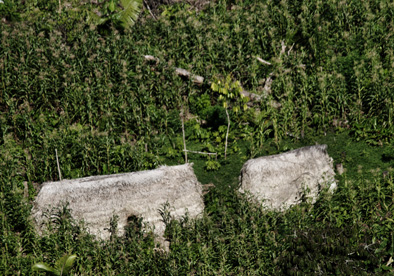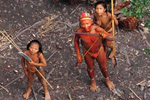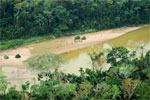The Brazilian government confirmed the existence of a community of uncontacted Amerindians in a protected area near the Peruvian border, reports Funai, Brazil’s Indian affairs agency.
Funai said the tribe came to the attention of authorities after satellite images revealed three large clearings in the Vale do Javari reservation, which is nearly the size of Portugal and is known to house at least 14 uncontacted tribes. Subsequent airplane fly-overs in April provided more data.
Funai estimates the community’s population at 200 people who live in four large straw-roofed structures that have been built within the last year. The tribe appears to grow bananas, corn, peanuts, and other crops.
 Picture of buildings in the newly discovered community. Image courtesy of Funai. |
Funai says the group likely belongs to the Pano linguistic family.
As is Brazilian government policy, Funai will not attempt to contact the group. However the government will work to protect their land from loggers, miners, ranchers and other invaders to ensure they can continue living in isolation should they wish.
“The main threats to the integrity of these groups are illegal fishing, hunting, logging, mining, large-scale farmers and ranchers, missionaries and frontier activities, like drug trafficking,” said Fabricio Amorim, the Funai coordinator for Vale do Javari. “Another situation that requires care is the oil exploration in Peru, which may impact the Indigenous Javari Valley.”
“The Indigenous Javari Valley is an isolated complex of peoples regarded as the highest concentration of isolated groups in the Amazon and the world,” he added in a statement. Some 2,000 indigenous people are thought to live in Javari.
Funai has identified 68 isolated communities in Brazil.
Indigenous reservations account for nearly 22 percent of the Brazilian Amazon.
Google Earth map
Related articles
Peru to abolish uncontacted tribe’s reserve, says group
(06/01/2011) Territory inhabited by an uncontacted Amazon tribe in Peru is again up for grabs, claims Survival International.
Incredible new photos of uncontacted tribe in the Amazon

(01/31/2011) Taken by Brazil’s Indian Affairs Department and released by indigenous-rights group, Survival International, new aerial photos show an uncontacted tribe on the border of Brazil and Peru in detail. According to a press release by Survival International, the photos “reveal a thriving, healthy community with baskets full of manioc and papaya fresh from their gardens”, but a community that is also threatened by illegal loggers from Peru.
Spotted uncontacted native flees, leaving dinner and dish behind
(07/07/2010) The man had set up camp and was preparing to cook live turtles for a meal when he was seen by people he did not know. He hid behind a tree and then fled from the camp into the forest, abandoning his uncooked turtles and a clay pot behind.
Spanish oil company develops own rules for contacting uncontacted Amazon tribes

(03/26/2010) Imagine you’re in one of the remotest parts of the Amazon rainforest and suddenly you come across members of an uncontacted tribe. What should you do? The experts say, “Turn around. At all costs, make no attempt at contact.” Repsol YPF, exploring for oil in northern Peru, has taken a different approach. Despite the extreme vulnerability of the tribes to any form of contact, the company suggests that its workers talk to them in certain instances, and even provides specific phrases to use and conversation topics to address.
Uncontacted natives confirmed in Brazil
(01/10/2010) An uncontacted tribe of about 60 people has been confirmed by FUNAI (Brazil’s Indigenous Affairs Department) in the Indigenous Territory of Arariboia, located in the eastern Amazonian state, Maranhao.
Brazil to use body-heat sensing technology to find uncontacted Amazon tribes
(11/19/2008) Brazil will use a plane equipped with body-heat sensing technology to locate tribes in the Amazon rainforest, reports the Associated Press.